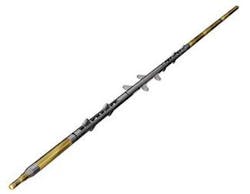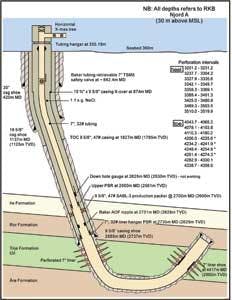Extending the reach in horizontal, deviated wells can recover more reserves
Brian Schwanitz, Douglas Johnson, Kristine Henriques - Welltec
Drilling extended reach horizontal and deviated wells has been limited by the availability of economical intervention techniques. There is no point in drilling long, horizontal wells if they cannot be serviced afterwards. Traditional methods such as coiled tubing, snubbing, and drill pipe all encountered problems or had logistical issues when trying to access extended reach (ER) wells. These problems included helical buckling (coiled tubing) and the heavy and expensive equipment required by snubbing and drill pipe. These older, intervention methods also were time consuming to mobilize, required a lot of manpower, and, because of the size of the equipment, had multiple HSE implications.
Thus, extending the reach of intervention techniques in extended reach wells was in demand as valuable working hours and production were lost on some of these wells as a result of technological inefficiencies. When electric wireline conveyance was introduced, it represented a paradigm shift in intervention methods. It is a highly cost- and time-efficient intervention option that enables access to reserves that conventional intervention methods may not reach.
One tool on the market is a downhole tractor that can reach the end of ER horizontal or highly deviated wells without deploying drill pipe or coiled tubing conveyance methods. This wireline-deployed, self-propelled robotic device can push or pull wireline tool strings out to the end of the wellbore. In this regard, any job typically that is run on electric wireline in a vertical well can be done in a horizontal or deviated well with the wireline tractor.
The high pull force enables the tool to reach almost all ER targets, and the high speed of both the equipment deployment and conveyance to target depth keeps operational costs down. In extreme reach wells, the tool can be configured for tandem operations, which increases deployment power and performance where major ID challenges are met.
Available in two sizes (2 1⁄8 in. [5.4 cm] and 3 1⁄8 in. [8 cm] OD), the wireline tractor is optimized for pulling force and speed in conjunction with the downhole completion string. It can push large open-hole tool strings into open-hole environments (including ones with washouts), and withstand the shocks of perforating.
Track record
Any job previously done on slick-line, in vertical wells can be done with a wireline tractor in extended reach wells. These jobs include perforating, cement bond logging, production logging, running open hole logs, and enabling coiled tubing (a coiled tubing tractor has also been developed) to reach beyond the friction buckle point. Custom-made, downhole robotic solutions also are being developed on demand.
Following are a few of the world records set with wireline-based, downhole robotics:
- Hibernia depth record: Ran to 30,888 ft (9,415 m) in one run
- Longest distance driven in one run: 20,500 ft (6,248 m), in the Gulf of Mexico in a well with an 83° deviation
- Heaviest tool string conveyed (including a Formation Tester): 3,200 lbs (1,451 kg) in a well with a 102º deviation in Norway
- Highest temperature: 388° F (198° C) in Canada.
Coiled tubing alternative
To supplement the wireline tractor, a fluid driven version also is available. This coiled tubing (CT) tractor extends the reach of coiled tubing in highly deviated or tortuous wells where conventional intervention techniques cannot reach. For instance, when using the standard coiled tubing alternative, there are lateral reach limitations due to coil buckle, causing forward motion to stop while running in hole. Furthermore, common effects such as unexpected friction can limit coiled tubing reach.
The fluid-driven CT tractor extends coiled tubing’s lateral reach capability in both horizontal and deviated wells because of the pulling force it puts at the end of the coil. Typically, the CT tractor can extend the reach 1,000 ft (305 m) beyond any other method. It pulls the coiled tubing into the wellbore, overcoming the tendency of the coil to buckle and lock up. This allows the use of a smaller diameter coil with less wall thickness or composite coiled tubing, which reduces the reel weight while reducing problems associated with crane lifting limitations. One CT tractor can apply up to 3,500 lbs of pull force in a standard configuration. Different configurations can triple the pull force to 10,000 lbs when stacking three CT tractors.
Mechanical services
The remotely operated, downhole robotic technologies have expanded beyond the scope of conveying tools in extended reach wells. Since 2003, it has been possible to combine tractor conveyance systems with a variety of downhole robotic tools to perform a variety of mechanical services in horizontal and highly deviated wells, and even vertical wells. There are wireline, downhole robotic systems performing valve manipulations, plug setting/pulling, cleaning and milling operations (with integrated debris bailing chambers), sliding sleeve exercises, and even nipple removing.
HSE benefits
A coiled tubing or wireline tractor is about 20 ft (6 m) long and a few inches wide. Because of small equipment size, interventions can be done with such a high degree of precision that they do not affect the rest of the reservoir or risk damaging the well or the surrounding environment. This contrasts to the very large equipment weighing up to many tons required by traditional intervention methods.
As to logistics, there are ample benefits. The tractors can fly on a helicopter and do not depend on a drilling rig. The equipment requires a crew of two people to operate, especially important offshore where logistical limitations are high.
Because the equipment is remote controlled, it can be operated miles away from the actual point of intervention, which means ecological systems in the area are not affected by the interventions. This is crucial in sensitive areas such as the Alaskan tundra where rolling in heavy equipment could have consequences
Case history: Zonal isolation in 130° U-shaped Norwegian well
In order to shut off a gas breakthrough in a 130° deviated fish hook well, a 262-ft (80-m) long “one run” straddle assembly needed to be installed. The well was in a subsea completed oil field offshore northwest Norway connected to a floating drilling and production unit. It was completed with a 7-in. (18-cm) production tubing and a 7-in. perforated liner. According to simulations, conventional coiled tubing would buckle and lockup 570 ft (174 m) from target depth. Thus, the CT tractor was applied to push the 2,000 lbs bottomhole assembly an equivalent of 614 ft (187 m) vertically, uphill. The operation reduced gas to oil ratio from 3,000 to 1,600 Sm3/Sm3, while increasing oil production to 1,500 cu m/d. There was no alternative; conventional methods could not have reached the desired depth.
Case history: World record with CT perforating, offshore UK
A tandem CT tractor was used for a perforating job where it was engaged to deploy 2,000 ft (610 m) of 3 3/8-in. (8.6-cm) high shot density perforating guns in two runs. The string weight of each bottomhole assembly exceeded 17,000 lbs (7,711 kg), so in order to achieve maximum pull force, two CT tractors were run in tandem. The two intervals were perforated at 820 ft (250 m) and 1,066 ft (325 m) using a pressure pulse firing system. During this operation, the cumulative distance covered reached almost 5,000 ft (1,524 m) while the well deviation reached 92°. The CT tractor pulled the coiled tubing beyond the normal buckling depth where traditional intervention techniques would have come to a halt.
As a result of applying the CT tractors, the number of runs was reduced from four to two. Furthermore, the platform was notorious for its people-on-board restrictions, which made the reduced manpower requirements for the CT tractor crucial.
Case history: Setting sump packer in extended reach well, Gulf of Mexico
In the GoM, the electric wireline tractor was used to set a 5 7/8-in. (15-cm) sump packer in conjunction with a setting tool and a gamma ray tool/casing locator. First, a cement bond log was performed in 11 hours; during the second run, the packer assembly was run in hole in 9 5/8-in. (24.4-cm) and 7-in. (18-cm) casing to 25,491 ft (7,770 m) MD, depth control was correlated and the packer was set, which took a total of 13 hours. Compared to a pipe conveyed intervention, the operator saved two days by using the wireline tractor on this job.
A total distance of 3,732 ft (1,138 m) was run where total depth for the wireline tractor reached 25,491 ft and the maximum deviation was 74°. The well is an extended reach record well that also holds the record for having the deepest tractor run in the GoM.



